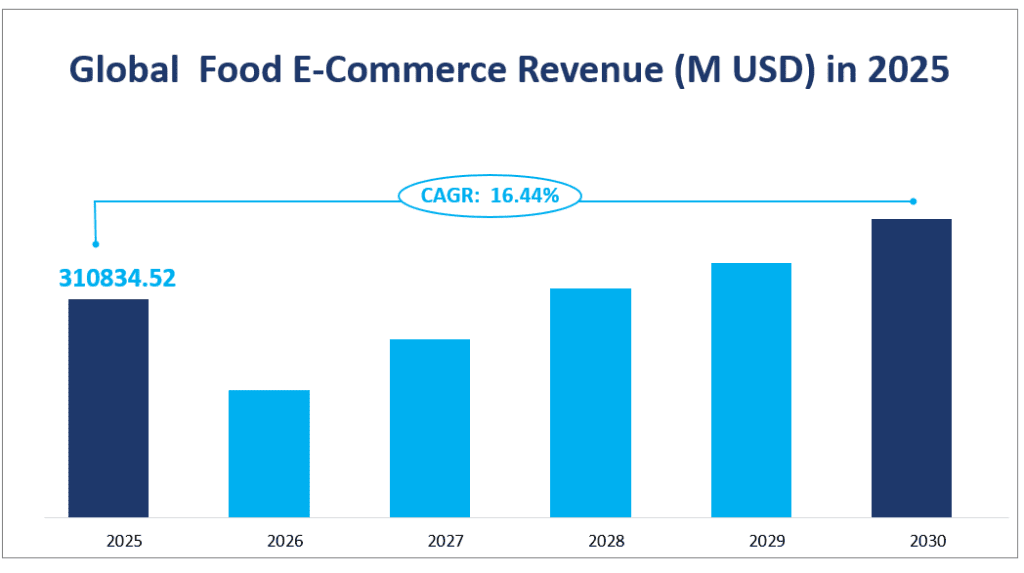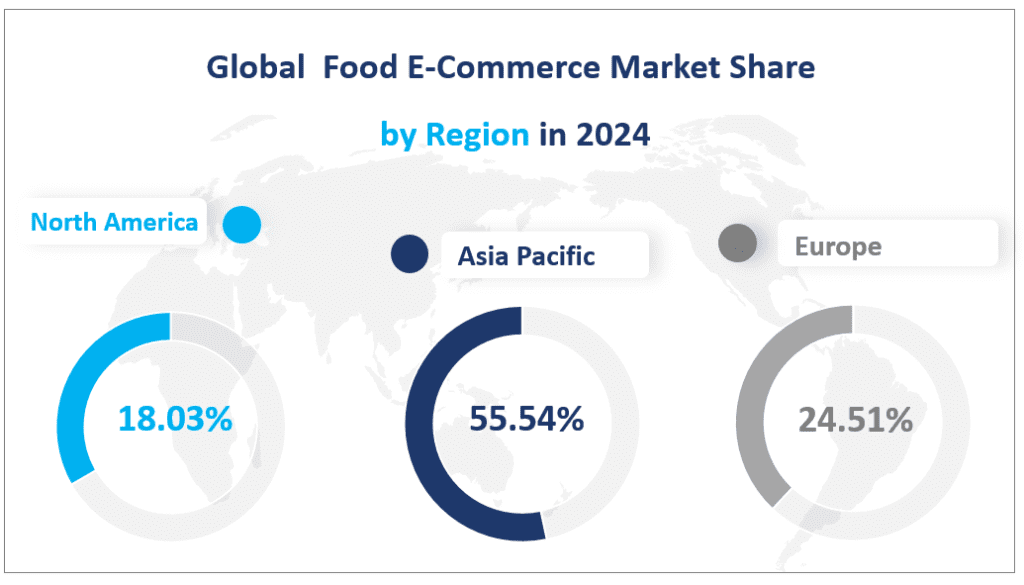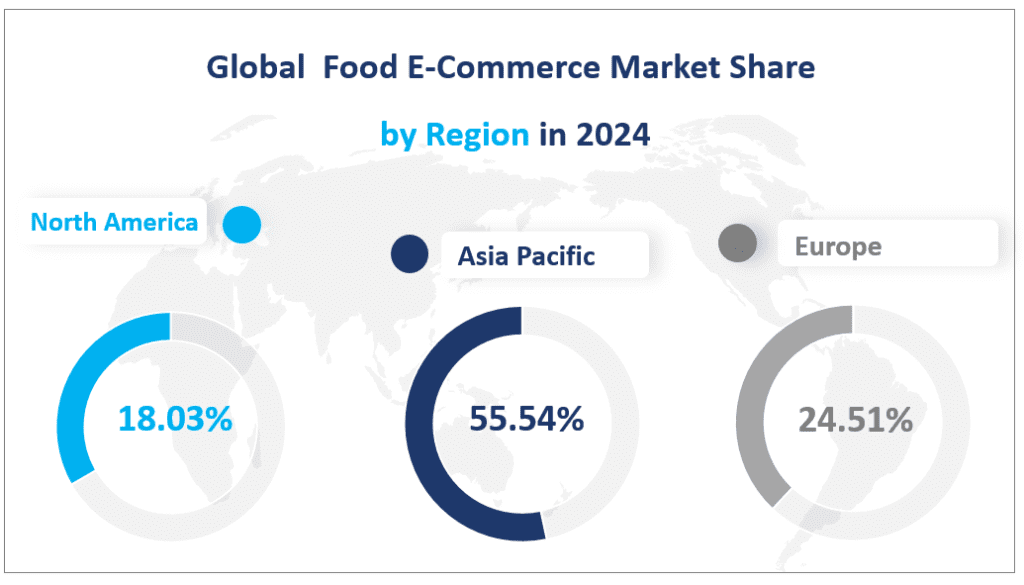1. Global Food E-Commerce Market Revenue in 2024
In 2024, the global food e-commerce market is expected to reach a revenue of $310834.52 million in 2024 with a CAGR of 16.44% from 2024 to 2029.
This growth is driven by several factors, including the increasing preference for convenience among consumers, the proliferation of smartphones, and the development of user-friendly mobile applications. These technologies have significantly enhanced the accessibility of food e-commerce, allowing customers to easily explore menus, compare prices, and place orders with a few clicks on their devices. The simplicity of mobile ordering, combined with user-friendly interfaces and personalized recommendations, improves the overall shopping experience, making it more interesting and efficient.
Global Food E-Commerce Market Revenue (M USD) in 2025


2. Driving Factors of Food E-Commerce Market Growth
Convenience and Time Savings: Modern lifestyles are increasingly busy, with longer working hours and a multitude of daily obligations. Food e-commerce provides a convenient option for ordering groceries, restaurant meals, and prepared foods from the comfort of one’s home. This not only saves vital time but also minimizes the work required for traditional shopping and meal preparation, making it an appealing option for busy individuals and families.
Technology and Mobile Applications: The proliferation of smartphones and the creation of user-friendly mobile applications have greatly enhanced the accessibility of food e-commerce. These technologies allow customers to easily explore menus, compare prices, and place orders with a few clicks on their displays. The simplicity of mobile ordering, combined with user-friendly interfaces and personalized recommendations, improves the overall shopping experience, making it more interesting and efficient.
Variety of Products: Online buyers have access to a wide range of goods, from everyday necessities to specialty items that may not be available in local retailers. This variety caters to a wide range of consumer preferences and nutritional concerns, including organic, gluten-free, vegan, and international cuisines. The ability to easily locate and purchase these items online provides a significant advantage over traditional shopping techniques.
Same-Day Delivery Services: The rise of same-day delivery services and the spread of delivery apps such as Instacart and Uber Eats have considerably reduced the issue of timely delivery. These systems allow food e-commerce enterprises to guarantee short delivery timeframes and near-instant enjoyment, thus solving one of the most significant challenges in online food sales.
Social Media and Influencer Marketing: Social media platforms are becoming vital sales channels for food and beverage brands. Social commerce allows consumers to discover and purchase products directly through social media apps like Instagram, Facebook, and TikTok. This trend is driven by the increasing influence of social media on consumer behavior and the seamless integration of shopping features into these platforms. Brands can leverage influencers and user-generated content to boost engagement and drive sales.
3. Limiting Factors of Food E-Commerce Market Growth
Supply Chain Challenges: The food supply chain is complex and requires strict operational procedures to ensure food safety and quality. Poor communication between supply chain partners, rising demand for shipping traceability, expanding regulations, and a lack of transparency and openness have plagued the food and beverage supply chain. These challenges make planning, manufacturing, logistics, and pricing decisions more difficult.
Logistical Constraints: The need for efficient and reliable logistics is crucial in the food e-commerce market. Challenges such as changing commodity prices, supply chain disruptions, and shortages of specific products in some regions make it difficult to maintain consistent delivery times and product availability. The new CDC guidelines for long-haul truck drivers, fast-changing local delivery laws, and the requirement to clean and sanitize trucks all place additional strain on logistic networks.
Quality and Freshness Concerns: Consumers are often concerned about the quality and freshness of food products when purchasing online. Ensuring that perishable items are delivered in optimal condition requires advanced cold chain logistics and quality control measures, which can be costly and complex.
Competition from Traditional Retailers: Traditional brick-and-mortar retailers continue to compete with online platforms, offering their own e-commerce solutions and in-store pickup options. This competition can limit the food e-commerce market share that online-only platforms can capture.
4. Global Food E-Commerce Market Segment
Product Types of Food E-Commerce Market
Traditional: This category includes products sold through traditional e-commerce platforms and websites. In 2024, the traditional segment is expected to generate a significant portion of the market revenue. The revenue for traditional products is estimated to be $211032.54 million.
Online-Only: This category includes products sold exclusively through online channels, often with a focus on digital marketing and direct-to-consumer sales. The revenue for online-only products is estimated to be $99801.98 million in 2024.
Traditional products are expected to have the largest market share with 67.89% in 2024. This is due to the established nature of traditional e-commerce platforms and the wide range of products available. Traditional e-commerce has been a dominant force in the market for several years, and it continues to hold a significant portion of the market share.
While traditional products hold the largest market share, the online-only segment is expected to have the fastest growing rate. The growth in this segment is driven by the increasing adoption of digital marketing strategies, the rise of social media influence, and the convenience of direct-to-consumer sales. Online-only platforms can offer personalized experiences and targeted marketing, which has led to a significant increase in consumer engagement and sales.
Different Applications of Food E-Commerce Market
Household: This application includes purchases made by individual households for their daily consumption. In 2024, the household segment is expected to generate the majority of the revenue, reflecting the high demand for food products in this category. The revenue for the household application is estimated to be $273,406.62 million.
Commercial: This application includes purchases made by businesses for their operations, such as restaurants, hotels, and corporate offices. The commercial segment also contributes significantly to the market revenue, although it is smaller compared to the household segment. The revenue for the commercial application is estimated to be $37,427.90 million.
The household application is expected to have the largest market share with 87.96% in 2024. This is due to the essential nature of food products for daily consumption in households. The high frequency of purchases and the wide range of products required for household use make this segment the dominant player in the food e-commerce market.
The commercial application is expected to have the fastest growing rate. The growth in this segment is driven by the increasing demand from the hospitality and food service industries, which are expanding their operations and requiring more frequent and larger quantities of food products. The CAGR for the commercial application is expected to be higher than the household application, reflecting the strong growth potential in this segment.
Market Revenue and Share by Segment
| Revenue (M USD) in 2024 | Market Share in 2024 | ||
| By Type | Traditional | 211032.54 | 67.89% |
| Online-Only | 99801.98 | 32.11% | |
| By Application | Household | 273406.62 | 87.96% |
| Commercial | 37427.90 | 12.04% |
5. Regional Food E-Commerce Market in 2024
Asia-Pacific: This region is expected to generate the highest revenue in 2024, estimated at $172,628.89 million. The Asia-Pacific region includes countries like China, Japan, South Korea, Australia, India, and others, which have seen significant growth in e-commerce due to the rapid adoption of digital technologies and the large consumer base.
Europe: This region is expected to generate a revenue of $76,185.45 million. Europe has a well-established e-commerce infrastructure and a high level of consumer awareness, which has contributed to its significant market share.
North America: This region is expected to generate a revenue of $56,028.74 million. North America, particularly the United States, has been a pioneer in e-commerce and continues to be a major player in the global food e-commerce market.
South America: This region is expected to generate a revenue of $2830.43 million. South America is seeing a growing trend in e-commerce, driven by improving internet penetration and economic development.
Middle East & Africa: This region is expected to generate a revenue of $311.11 million. The Middle East and Africa are emerging food e-commerce market with significant growth potential, driven by the increasing use of mobile devices and the expansion of e-commerce platforms.
Asia-Pacific has the largest market share in 2024. This is due to the region’s large population, rapid economic growth, and the increasing adoption of digital technologies. The Asia-Pacific region has been a leader in e-commerce, with countries like China and India driving significant growth in the sector. The high demand for a wide variety of food products and the convenience of online shopping has made this region a dominant player in the global food e-commerce market.
Global Food E-Commerce Market Share by Region in 2024


6. Analysis of Top 3 Companies in the Global Food E-Commerce Market
CAmazon is the largest online e-commerce company in the United States, located in Seattle, Washington. It was one of the first companies to start e-commerce on the Internet. Amazon was founded in 1995. In the beginning, it only operated online book sales. Now it has expanded into a wide range of other products and has become the world’s largest online retail platform. The company also includes subsidiaries such as Alexa Internet, a9, lab126, and Internet Movie Database (IMDB).
Amazon offers a wide range of products, including groceries, beverages, ready-to-eat meals, snacks, and confectionery. The company has a vast selection of fresh and packaged foods, catering to a wide range of consumer preferences.
Tesco PLC, through its subsidiaries, operates as a food retailer. The company offers online retailing, brick-and-mortar supermarkets, and a private-label brand of products. Tesco provides its services primarily throughout Europe, with additional activities in Asia.
Tesco offers a comprehensive range of food products, including groceries, beverages, ready-to-eat meals, snacks, and confectionery. The company is known for its private-label products, which offer quality at competitive prices.
Walmart is a global chain of American companies with the largest turnover in the world in terms of turnover. Its controlling shareholder is the Walton family. Headquartered in Bentonville, Arkansas, USA, Walmart is primarily involved in the retail industry and is the most employee-owned company in the world. Walmart operates in 50 states and Puerto Rico and has 8,500 stores in 15 countries around the world.
Walmart offers a wide range of food products, including groceries, beverages, ready-to-eat meals, snacks, and confectionery. The company is known for its extensive selection and competitive prices, making it a popular choice for consumers.
Major Players
| Company Name | Sales Regions |
| Amazon | Worldwide |
| Tesco | Mainly in Europe, Asia |
| Walmart | Worldwide |
| Kroger | Worldwide |
| E.Leclerc | France |
| Ocado | Worldwide |
| Sainsbury’s | UK |
| Carrefour | Worldwide |
| Peapod | USA |
| JD.com, Inc | China |
| Albert Heijn | Netherlands |
| Costco | Worldwide |
| Target | USA |
| Rakuten | Japan |
| Alibaba Group | Worldwide |
1 Food E-Commerce Market Overview
1.1 Product Overview and Scope of Food E-Commerce
1.2 Classification of Food E-Commerce by Type
1.2.1 Global Food E-Commerce Revenue Comparison by Type (2015-2027)
1.2.2 Global Food E-Commerce Revenue Market Share by Type in 2019
1.2.3 Traditional
1.2.4 Online-Only
1.3 Global Food E-Commerce Market by Applications
1.3.1 Household
1.3.2 Commercial
1.4 Global Food E-Commerce Market by Regions
1.4.1 North America (United States, Canada and Mexico) Food E-Commerce Status and Prospect (2015-2027)
1.4.2 Europe (Germany, UK, France, Italy, Spain, Russia Netherlands, Belgium, Czech Republic and Nordics) Food E-Commerce Status and Prospect (2015-2027)
1.4.3 Asia-Pacific (China, Japan, South Korea, Australia, India, Taiwan and Indonesia) Food E-Commerce Status and Prospect (2015-2027)
1.4.4 South America (Brazil, Argentina, Columbia and Chile) Food E-Commerce Status and Prospect (2015-2027)
1.4.5 Middle East and Africa (Saudi Arabia, UAE, Egypt, Nigeria and South Africa) Food E-Commerce Status and Prospect (2015-2027)
1.4.6 South East Asia (Singapore, Malaysia, Vietnam, and Thailand) Food E-Commerce Status and Prospect (2015-2027)
1.5 Global Market Size of Food E-Commerce (2015-2027)
2 Manufacturers Profiles
2.1 Amazon
2.1.1 Business Overview
2.1.2 Products Analysis
2.1.3 Amazon Food E-Commerce Revenue, Gross Margin
2.2 Tesco
2.2.1 Business Overview
2.2.2 Products Analysis
2.2.3 Tesco Food E-Commerce Revenue, Gross Margin
2.3 Walmart
2.3.1 Business Overview
2.3.2 Products Analysis
2.3.3 Walmart Food E-Commerce Revenue, Gross Margin
2.4 Kroger
2.4.1 Business Overview
2.4.2 Products Analysis
2.4.3 Kroger Food E-Commerce Revenue, Gross Margin
2.5 E.Leclerc
2.5.1 Business Overview
2.5.2 Products Analysis
2.5.3 E.Leclerc Food E-Commerce Revenue, Gross Margin
2.6 Ocado
2.6.1 Business Overview
2.6.2 Products Analysis
2.6.3 Ocado Food E-Commerce Revenue, Gross Margin
2.7 Sainsbury’s
2.7.1 Business Overview
2.7.2 Products Analysis
2.7.3 Sainsbury’s Food E-Commerce Revenue, Gross Margin
2.8 Carrefour
2.8.1 Business Overview
2.8.2 Products Analysis
2.8.3 Carrefour Food E-Commerce Revenue, Gross Margin
2.9 Peapod
2.9.1 Business Overview
2.9.2 Products Analysis
2.9.3 Peapod Food E-Commerce Revenue, Gross Margin
2.10 JD.com, Inc
2.10.1 Business Overview
2.10.2 Products Analysis
2.10.3 JD.com, Inc Food E-Commerce Revenue, Gross Margin
2.11 Albert Heijn
2.11.1 Business Overview
2.11.2 Products Analysis
2.11.3 Albert Heijn Food E-Commerce Revenue, Gross Margin
2.12 Costco
2.12.1 Business Overview
2.12.2 Products Analysis
2.12.3 Costco Food E-Commerce Revenue, Gross Margin
2.13 Target
2.13.1 Business Overview
2.13.2 Products Analysis
2.13.3 Target Food E-Commerce Revenue, Gross Margin
2.14 Rakuten
2.14.1 Business Overview
2.14.2 Products Analysis
2.14.3 Rakuten Food E-Commerce Revenue, Gross Margin
2.15 Alibaba Group
2.15.1 Business Overview
2.15.2 Products Analysis
2.15.3 Alibaba Group Food E-Commerce Revenue, Gross Margin
3 Global Food E-Commerce Market Competition, by Players
3.1 Global Food E-Commerce Revenue and Share by Players (2015-2020)
3.2 Market Concentration Rate
3.2.1 Top 3 Food E-Commerce Players Market Share
3.2.2 Top 6 Food E-Commerce Players Market Share
4 Global Food E-Commerce Market Size by Regions
4.1 Global Food E-Commerce Revenue and Market Share by Regions
4.2 North America Food E-Commerce Revenue and Growth Rate (2015-2020)
4.3 Europe Food E-Commerce Revenue and Growth Rate (2015-2020)
4.4 Asia-Pacific Food E-Commerce Revenue and Growth Rate (2015-2020)
4.5 South America Food E-Commerce Revenue and Growth Rate (2015-2020)
4.6 Middle East and Africa Food E-Commerce Revenue and Growth Rate (2015-2020)
4.7 South East Asia Food E-Commerce Revenue and Growth Rate (2015-2020)
5 North America Food E-Commerce Revenue by Countries
5.1 North America Food E-Commerce Revenue by Countries (2015-2020)
5.2 United States Food E-Commerce Revenue and Growth Rate (2015-2020)
5.3 Canada Food E-Commerce Revenue and Growth Rate (2015-2020)
5.4 Mexico Food E-Commerce Revenue and Growth Rate (2015-2020)
6 Europe Food E-Commerce Revenue by Countries
6.1 Europe Food E-Commerce Revenue by Countries (2015-2020)
6.2 Germany Food E-Commerce Revenue and Growth Rate (2015-2020)
6.3 UK Food E-Commerce Revenue and Growth Rate (2015-2020)
6.4 France Food E-Commerce Revenue and Growth Rate (2015-2020)
6.5 Italy Food E-Commerce Revenue and Growth Rate (2015-2020)
6.6 Spain Food E-Commerce Revenue and Growth Rate (2015-2020)
6.7 Russia Food E-Commerce Revenue and Growth Rate (2015-2020)
6.8 Netherlands Food E-Commerce Revenue and Growth Rate (2015-2020)
6.9 Belgium Food E-Commerce Revenue and Growth Rate (2015-2020)
6.10 Czech Republic Food E-Commerce Revenue and Growth Rate (2015-2020)
6.11 Nordics Food E-Commerce Revenue and Growth Rate (2015-2020)
7 Asia-Pacific Food E-Commerce Revenue by Countries
7.1 Asia-Pacific Food E-Commerce Revenue by Countries (2015-2020)
7.2 China Food E-Commerce Revenue and Growth Rate (2015-2020)
7.3 Japan Food E-Commerce Revenue and Growth Rate (2015-2020)
7.4 South Korea Food E-Commerce Revenue and Growth Rate (2015-2020)
7.5 Australia Food E-Commerce Revenue and Growth Rate (2015-2020)
7.6 India Food E-Commerce Revenue and Growth Rate (2015-2020)
7.7 Taiwan Food E-Commerce Revenue and Growth Rate (2015-2020)
7.8 Indonesia Food E-Commerce Revenue and Growth Rate (2015-2020)
8 South America Food E-Commerce Revenue by Countries
8.1 South America Food E-Commerce Revenue by Countries (2015-2020)
8.2 Brazil Food E-Commerce Revenue and Growth Rate (2015-2020)
8.3 Argentina Food E-Commerce Revenue and Growth Rate (2015-2020)
8.4 Columbia Food E-Commerce Revenue and Growth Rate (2015-2020)
8.5 Chile Food E-Commerce Revenue and Growth Rate (2015-2020)
9 Middle East and Africa Revenue Food E-Commerce by Countries
9.1 Middle East and Africa Food E-Commerce Revenue by Countries (2015-2020)
9.2 Saudi Arabia Food E-Commerce Revenue and Growth Rate (2015-2020)
9.3 UAE Food E-Commerce Revenue and Growth Rate (2015-2020)
9.4 Egypt Food E-Commerce Revenue and Growth Rate (2015-2020)
9.5 Nigeria Food E-Commerce Revenue and Growth Rate (2015-2020)
9.6 South Africa Food E-Commerce Revenue and Growth Rate (2015-2020)
10 South East Asia Revenue Food E-Commerce by Countries
10.1 South East Asia Food E-Commerce Revenue by Countries (2015-2020)
10.2 Singapore Food E-Commerce Revenue and Growth Rate (2015-2020)
10.3 Malaysia Food E-Commerce Revenue and Growth Rate (2015-2020)
10.4 Vietnam Food E-Commerce Revenue and Growth Rate (2015-2020)
10.5 Thailand Food E-Commerce Revenue and Growth Rate (2015-2020)
11 Global Food E-Commerce Market Segment by Type
11.1 Global Food E-Commerce Revenue and Market Share by Type (2015-2020)
11.2 Global Food E-Commerce Market Forecast by Type (2020-2027)
11.3 Traditional Revenue Growth Rate
11.4 Online-Only Revenue Growth Rate
12 Global Food E-Commerce Market Segment by Applications
12.1 Global Food E-Commerce Revenue Market Share by Applications (2015-2020)
12.2 Food E-Commerce Market Forecast by Applications (2020-2027)
12.3 Household Revenue Growth Rate (2015-2027)
12.4 Commercial Revenue Growth Rate (2015-2027)
13 Global Food E-Commerce Market Size Forecast (2020-2027)
13.1 Global Food E-Commerce Market Size Forecast (2020-2027)
13.2 Global Food E-Commerce Market Forecast by Regions (2020-2027)
13.3 North America Food E-Commerce Revenue Market Forecast (2020-2027)
13.4 Europe Food E-Commerce Revenue Market Forecast (2020-2027)
13.5 Asia-Pacific Food E-Commerce Revenue Market Forecast (2020-2027)
13.6 South America Food E-Commerce Revenue Market Forecast (2020-2027)
13.7 Middle East and Africa Food E-Commerce Revenue Market Forecast (2020-2027)
13.8 South East Asia Food E-Commerce Revenue Market Forecast (2020-2027)
14 Appendix
14.1 Methodology
14.2 Research Data Source
